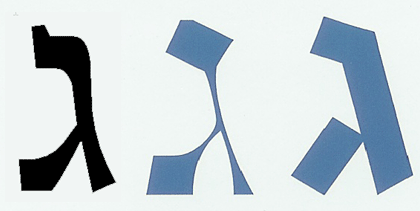I have just finished setting a new siddur. That has sucked up time, where there has been time, for a few months. Small project. Less time. I'll try to make some time today, though, to talk about what a wonderful new world I am facing using InDesign ME (supplied by the Font Blog sponsor, FontWorld, if I might extend a grateful plug).
I came down this morning to find an e-mail from Dan Sieradski (better known as "Mobius" of my favorite Jewish blog, Jew*School complaining that he had found a stash of very cool free fonts on the Internet, something called "Ben's fonts, but that he couldn't use them on his Mac with OS X. I downloaded them and confirmed that they were simply standard Windows Hebrew fonts. That's all Mobius needed - he found an appropriate utility to convert Windows to Mac TrueType (TTF) and he was off and running. I decided to try the slower, "read into FontLab, save as TrueType" route, which also works perfectly. Open the font. For whatever reason, FontLab saw these as "MacOS Roman" (odd, given that the fonts were Windows TTF—that may have been a default for the Macintosh version of FontLab). I then set the encoding "to "ISO-8859-8 Hebrew" and saved as OpenType (OTF). Now I have a single version that can be used on any of the household computers, be they Mac or Windows (or, coming soon, Linux).
There is probably a FontLab-related tool to automate this. I'll have to check. While I was at it, I also took a look at some fonts that came with the original version of Dagesh, back when my friends at Kivun, in Israel, were working on it. They don't seem to match any known encoding, but it occurs to me that it wouldn't be such a big deal to convert these, too, to OTF. Since the character sets are larger, the results would be useful for Hebrew with vowels, Yiddish, etc. It's not a project for this week, but it could be coming soon.



